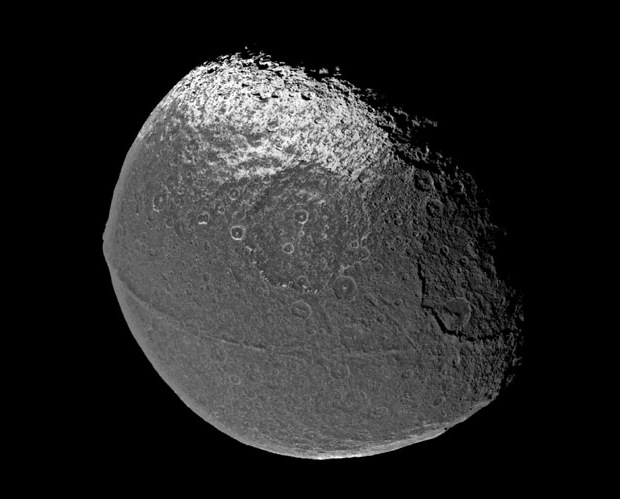Saturn Moon's Weird Ridge Rained Down from Space

Saturn certainly has some oddball moons and astronomers think they're close to explaining how a weird feature formed on one of them.
Iapetus is nearly 1,000 miles wide and has a 78 day orbit around the ringed gas giant. But one hemisphere of Iapetus is constantly facing Saturn -- in the same way Earth's moon is tidally locked with Earth -- and the little satellite has a very obvious two-tone surface.
It's Iapetus' weird equatorial ridge of mountains, however, that has had scientists scratching their heads. Now, with the help of 3-D maps composed from Cassini data, researchers think they have the most likely cause of the mountains pinned down.
Typically, mountains on Earth are formed as a side effect of plate tectonics and volcanic activity. Alas, Iapetus appears to have neither and, besides, the 6 mile-high mountains are too steep to be explained away by conventional mountain-forming mechanisms. So how did the mountains get there?
The researchers reckon the material that formed the Iapetian mountains have "exogenic" origin. In other words, they came from space.
NEWS: Saturn May Have Given Birth to a Baby Moon
Breaking space news, the latest updates on rocket launches, skywatching events and more!
In a paper submitted to the arXive preprint service, the researchers point to a possible collision between Iapetus and another planetary body that generated a huge quantity of debris. This debris settled into orbit around Iapetus' equator and eventually "rained" down from orbit, piling up to form the equatorial mountains.
This new theory is a variant of another idea that Iapetus may have possessed its own moon that became tidally shredded to create a ring system that eventually fell to the moon's surface.
But whatever the source, it seems scientists are agreeing that Iapetus couldn't have created the mountain range without some help from up above.
This article was provided by Discovery News.
Join our Space Forums to keep talking space on the latest missions, night sky and more! And if you have a news tip, correction or comment, let us know at: community@space.com.
Ian O'Neill is a media relations specialist at NASA's Jet Propulsion Laboratory (JPL) in Southern California. Prior to joining JPL, he served as editor for the Astronomical Society of the Pacific‘s Mercury magazine and Mercury Online and contributed articles to a number of other publications, including Space.com, Space.com, Live Science, HISTORY.com, Scientific American. Ian holds a Ph.D in solar physics and a master's degree in planetary and space physics.
